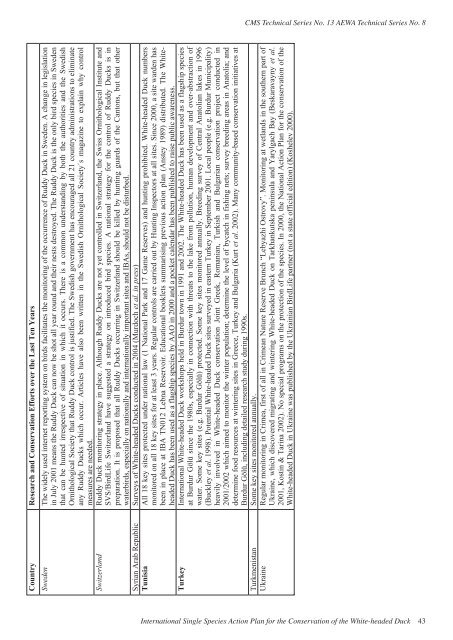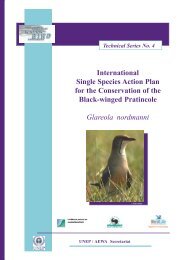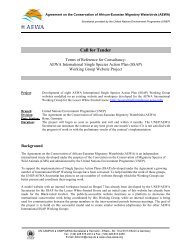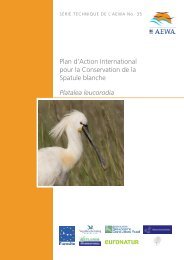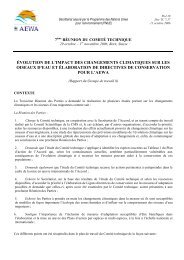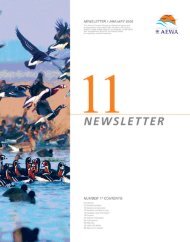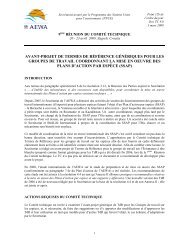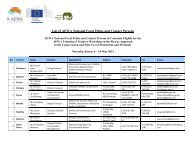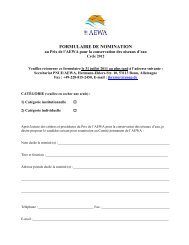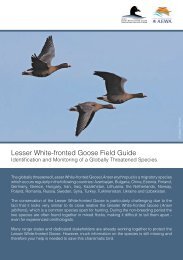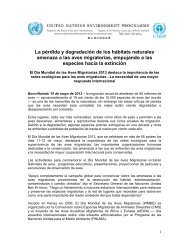International Single Species Action Plan for the Conservation - AEWA
International Single Species Action Plan for the Conservation - AEWA
International Single Species Action Plan for the Conservation - AEWA
You also want an ePaper? Increase the reach of your titles
YUMPU automatically turns print PDFs into web optimized ePapers that Google loves.
Country Research and <strong>Conservation</strong> Ef<strong>for</strong>ts over <strong>the</strong> Last Ten Years<br />
Sweden The widely used internet reporting system on birds facilitates <strong>the</strong> monitoring of <strong>the</strong> occurrence of Ruddy Duck in Sweden. A change in legislation<br />
in July 2001 means <strong>the</strong> Ruddy Duck can now be shot all year round and <strong>the</strong>ir nests destroyed. The Ruddy Duck is <strong>the</strong> only bird species in Sweden<br />
that can be hunted irrespective of situation in which it occurs. There is a common understanding by both <strong>the</strong> authorities and <strong>the</strong> Swedish<br />
Ornithological Society that Ruddy Duck control is justified. The Swedish government has encouraged all 21 country administrations to eliminate<br />
any Ruddy Ducks which occur. Articles have also been written in <strong>the</strong> Swedish Ornithological Society´s magazine to explain why control<br />
measures are needed.<br />
Switzerland Ruddy Duck monitoring strategy in place. Although Ruddy Ducks are not yet controlled in Switzerland, <strong>the</strong> Swiss Ornithological Institute and<br />
SVS/BirdLife Switzerland have suggested a strategy on introduced bird species. A national strategy <strong>for</strong> <strong>the</strong> control of Ruddy Ducks is in<br />
preparation. It is proposed that all Ruddy Ducks occurring in Switzerland should be killed by hunting guards of <strong>the</strong> Cantons, but that o<strong>the</strong>r<br />
waterbirds, especially on nationally and internationally important sites and IBAs, should not be disturbed.<br />
Syrian Arab Republic Surveys of White-headed Ducks conducted in 2004 (Murdoch et al. in press)<br />
Tunisia All 18 key sites protected under national law (1 National Park and 17 Game Reserves) and hunting prohibited. White-headed Duck numbers<br />
monitored on all 18 key sites <strong>for</strong> at least 3 years. Regular controls are carried out by Hunting Inspectors at all sites. Since 2000, a site warden has<br />
been in place at IBA TN012 Lebna Reservoir. Educational booklets summarising previous action plan (Anstey 1989) distributed. The Whiteheaded<br />
Duck has been used as a flagship species by AAO in 2000 and a pocket calendar has been published to raise public awareness.<br />
Turkey <strong>International</strong> White-headed Duck workshops held in Burdur town in 1991 and 2002. The White-headed Duck has been used as a flagship species<br />
at Burdur Gölü since <strong>the</strong> 1980s, especially in connection with threats to <strong>the</strong> lake from pollution, human development and over-abstraction of<br />
water. Some key sites (e.g. Burdur Gölü) protected. Some key sites monitored annually. Breeding survey of Central Anatolian lakes in 1996<br />
(Buckley et al. 1998). Potential White-headed Duck sites surveyed in eastern Turkey in September 2001. Local people (e.g. Burdur Municipality)<br />
heavily involved in White-headed Duck conservation Joint Greek, Romanian, Turkish and Bulgarian conservation project conducted in<br />
2001/2002 which aimed to monitor <strong>the</strong> winter population; determine <strong>the</strong> level of bycatch in fishing nets; survey breeding areas in Anatolia; and<br />
determine food resources at wintering sites in Greece, Turkey and Bulgaria (Kurt et al. 2002). Many community-based conservation initiatives at<br />
Burdur Gölü, including detailed research study during 1990s.<br />
Turkmenistan Some key sites monitored annually.<br />
Ukraine Regular monitoring in Crimea, first of all in Crimean Nature Reserve Brunch “Lebyazhi Ostrovy”. Monitoring at wetlands in <strong>the</strong> sou<strong>the</strong>rn part of<br />
Ukraine, which discovered migrating and wintering White-headed Duck on Tarkhankutska peninsula and Yarylgach Bay (Beskaravayny et al.<br />
2001, Kostin & Tarina 2002). No special programs on <strong>the</strong> protection of <strong>the</strong> species. In 2000, <strong>the</strong> National <strong>Action</strong> <strong>Plan</strong> <strong>for</strong> <strong>the</strong> conservation of <strong>the</strong><br />
White-headed Duck in Ukraine was published by <strong>the</strong> Ukrainian BirdLife partner (not a state official edition) (Koshelev 2000).<br />
CMS Technical Series No. 13 <strong>AEWA</strong> Technical Series No. 8<br />
<strong>International</strong> <strong>Single</strong> <strong>Species</strong> <strong>Action</strong> <strong>Plan</strong> <strong>for</strong> <strong>the</strong> <strong>Conservation</strong> of <strong>the</strong> White-headed Duck 43


